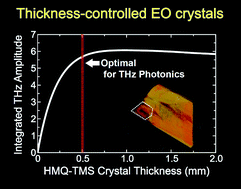Electro-optic crystals grown in confined geometry with optimal crystal characteristics for THz photonic applications†
Abstract
We report a new crystal engineering technique for the thickness-controlled growth of large-area organic electro-optic crystals in confined geometry optimal for THz wave photonics. We investigate the relationship between the material properties and THz generation characteristics to determine the optimal crystal characteristics for THz applications. Two different state-of-the-art nonlinear optical organic crystals are chosen as model crystals, ionic quinolinium-based and non-ionic polyene-based crystals. Both kinds of electro-optic crystals grown in confined geometry exhibit good optical quality, large area and sub-millimeter-scale thickness, which are optimal crystal characteristics for efficient THz wave generation. In order to investigate the relationship between crystal characteristics and optical-to-THz conversion characteristics, THz experiments with quinolinium crystals are performed and compared with theoretical calculations. The characteristics of the generated THz waves from as-grown quinolinium-based single crystals in confined geometry match well with those from very flat quinolinium crystals prepared from bulk crystals by a cutting method and also with theoretical calculations.

- This article is part of the themed collection: Solid-State Photochemistry

 Please wait while we load your content...
Please wait while we load your content...